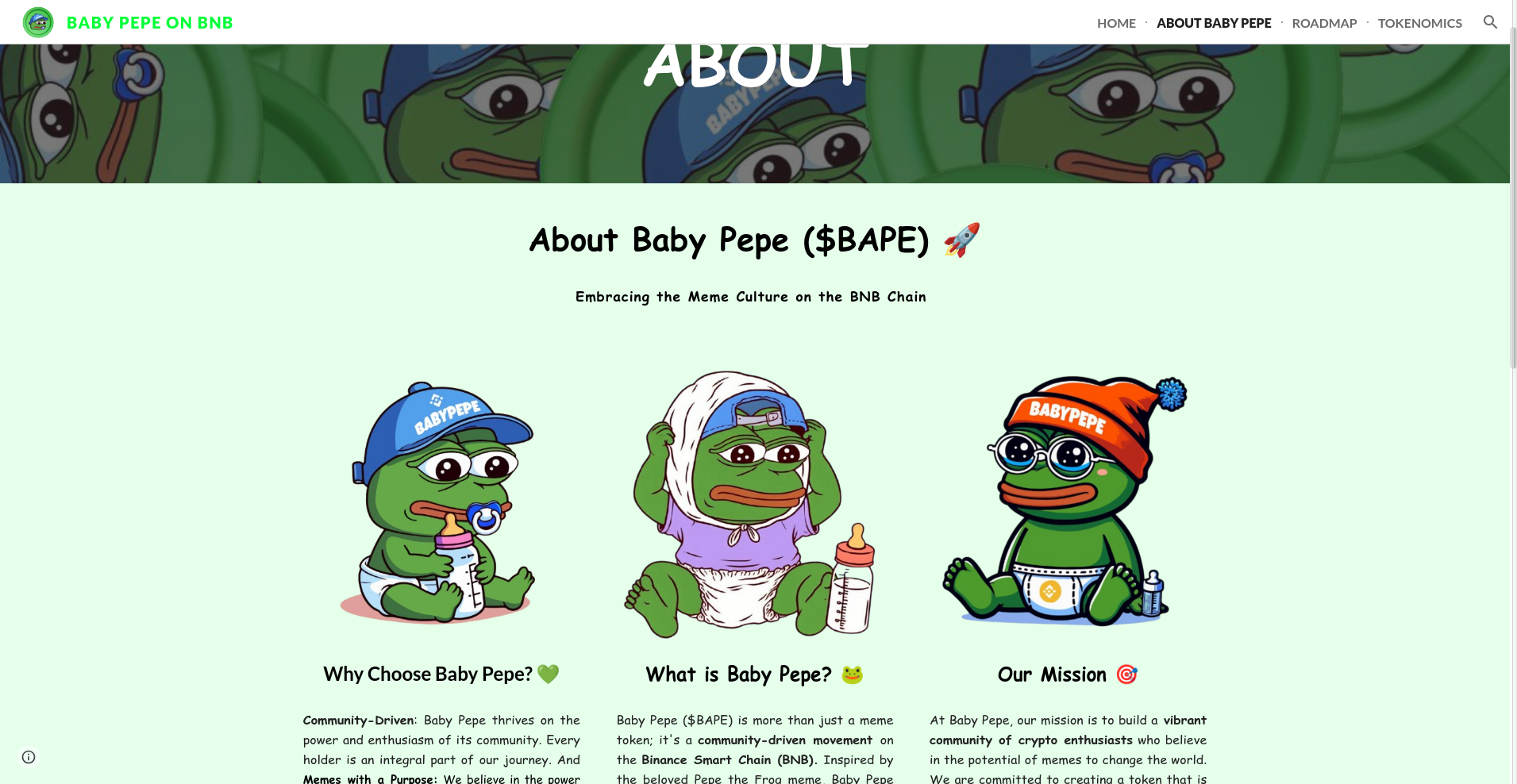BabyPepe ($BAPE) Review: A Data-Driven Legitimacy and Risk Assessment of This Meme Coin

What Is BabyPepe: An Introduction
BabyPepe emerges as a meme-inspired cryptocurrency operating on the Binance Smart Chain (BSC), with the token symbol $BAPE. Marketed as the "Next Big Meme Token" on BNB Chain, it aims to leverage meme culture's virality, particularly inspired by Pepe the Frog, to build a community-driven ecosystem. Its core proposition revolves around fostering a fun, engaging, and rewarding environment for holders through a combination of community initiatives and tokenomics strategies. For more on leveraging similar culture, see our article on meme culture's impact on cryptocurrency projects.
This review aims to provide an impartial, evidence-based analysis of BabyPepe's legitimacy and associated risks. By examining available data—such as security audits, tokenomics, development activity, and community engagement—we seek to inform potential investors, community members, and analytical observers about its strengths and vulnerabilities. Understanding the environment these tokens operate in, such as analysis of meme tokens on Binance Smart Chain, is crucial.

The Team and Roadmap Evaluation
Most details about BabyPepe’s team are absent from publicly available sources. The project's website and other references do not specify team members, advisors, or founders, which is common among meme coins that prioritize community participation over centralized development teams. The lack of identifiable leadership raises questions about accountability and long-term vision but is typical within the meme token sphere.
Assessing its roadmap reveals a strategic focus on community building and market expansion:
- Phase 1: Community creation, contract deployment, marketing, contests, and presale (sold out). This phase indicates initial interest but relies heavily on early community enthusiasm.
- Phase 2: Listing on PancakeSwap, CMC and CG listings, with a goal of over 1500 holders. These are standard steps towards market recognition.
- Phase 3: Aim for major exchange listings, 100M market cap, merchandise launch, and 10,000 holders. Success here depends on genuine project development versus hype.
Overall, while the roadmap delineates ambitious milestones, the absence of a transparent team or verified development milestones warrants caution. Success hinges on whether the project can execute these plans beyond initial hype, which remains uncertain based on current data.
Assessing the Security and Integrity of BabyPepe
Our security assessment is primarily based on the Cyberscope audit report for BabyPepe, conducted on December 2, 2024. The audit focused on the token’s smart contract deployed at address 0x20ce35b852dacc92f32a16b900d54be6a3e1ee83 on BSC. You can learn more about how to interpret these by checking our guide on understanding Cyberscope audit reports.
Outcomes of the audit reflect a high-security score, with a security score percentile of around 90.55%, suggesting strong technical audits concerning standard smart contract vulnerabilities. However, it is noteworthy that only a single audit source is available; thus, comprehensive security validation remains limited. This highlights the importance of ensuring sufficient liquidity, which can be verified through tools like our guide on verifying crypto project liquidity.
- Security score: 89/100, placing it in the high-security category.
- Audit focus: Token contract, with no mention of additional security layers such as multisig, timelocks, or external security review verification.
- Critical vulnerabilities: None reported; however, high criticality indicators are noted as completed, pointing to existing issues being addressed.
- Limitations: Lack of multiple audit reports increases the risk of incomplete security validation.
While the audit provides some confidence in the smart contract's technical security, potential investors should remain cautious. The single audit does not exclude all risks, especially related to centralized control, wallet management, or external dependencies.
A Breakdown of BabyPepe Tokenomics
BabyPepe ($BAPE) adopts a straightforward tokenomics model consistent with community-driven meme tokens. Total supply is set at 69 billion $BAPE, with a distribution emphasizing presale and liquidity, typical of early-stage projects aiming for quick market entry.
- Total Supply: 69,000,000,000 BAPE
- Token Distribution:
- Presale: 54% — indicating a strong emphasis on early funding.
- Liquidity: 21% — allocated to ensure tradability on decentralized exchanges like PancakeSwap.
- CEX Listing: 10% — reserved for potential exchange listings to expand trading options.
- Team: 5% — a moderate allocation, but lacking transparency about vesting schedules.
- Burn: 5% — intended to reduce supply over time, potentially increasing scarcity.
- Transaction Tax: 5% on both buys and sells, but purpose (e.g., redistribution, marketing, liquidity) is unspecified. This aspect is further explored in our article on the utility of transaction taxes in crypto tokens.
This tokenomics structure emphasizes rapid community growth with a large presale and burn mechanisms. Nonetheless, the high presale percentage underscores a reliance on early investor funding, which could pose liquidity and centralization risks.
Economic sustainability depends on ongoing project development, real utility, and community engagement. Without clear utility beyond speculative hype, such models risk devaluation, especially if community enthusiasm wanes.
Assessing BabyPepe's Development and Ecosystem Activity
Data on BabyPepe's active development and ecosystem growth appears limited beyond initial milestones. The presale's success (sold out) indicates initial traction, but subsequent activity, such as updates, partnerships, or utility launches, is not thoroughly documented or verified.
Social engagement on platforms like Twitter and Telegram seems modest, with no prominent influencer activity or community reports suggesting organic growth. The absence of substantial collaboration or product development signals that the project might still be in early or speculative phases rather than mature development.
Genuine ecosystem development would typically be reflected in frequent updates, partnerships, or new features, none of which are clearly available from the current data. Therefore, current signals imply a project maintained primarily through marketing rather than concrete product delivery.
Reviewing the Terms and Conditions
Available documentation from BabyPepe, hosted primarily on Google Sites, does not reveal detailed legal terms, privacy policies, or comprehensive user agreements. This is typical for meme coins that focus on community hype. The absence of explicit terms introduces fundamental risks regarding investor protection, rights, and dispute resolution.
Potential concerns include:
- Insufficient transparency on token utility and governance.
- No clear policies on token burns, token holder rights, or dispute mechanisms.
- Possible lack of compliance with regional regulatory frameworks.
In the absence of detailed legal terms, investors should exercise caution regarding potential misuse of funds, rug pulls, or sudden contract changes, especially given the anonymous or unclear team structure.
Final Analysis: The Investment Case for BabyPepe
BabyPepe presents itself as an aspirational meme coin on BNB Chain, leveraging meme culture and community engagement as its core drivers. While the project has completed a presale, secured a high-security smart contract audit, and outlined an ambitious roadmap, significant concerns cloud its legitimacy and long-term viability.
The lack of transparent team information, limited ecosystem development evidence, and reliance on hype and presale success suggest high risk. Its tokenomics, while straightforward, is vulnerable to speculative bubbles common in meme tokens, and the security and legal frameworks appear minimal. The project's community engagement metrics also suggest small and possibly artificial social footprints.
Potential investors should consider that projects heavily reliant on community hype, with limited verifiable development or utility, tend to experience volatility or eventual decline once initial hype fades. Nevertheless, the project's high security audit score indicates a robust technical foundation, but this alone does not assure long-term value.
Pros / Strengths
- High security score from Cyberscope audit, indicating strong smart contract security
- Clear tokenomics with a significant presale and burn mechanism
- Well-defined milestones for community growth and exchange listings
- Active social channels and visible presale success
Cons / Risks
- Lack of transparent leadership or team credentials, raising accountability concerns
- Limited information on actual utility, product development, or partnerships
- Heavy presale reliance, which can lead to liquidity issues or pump-and-dump schemes
- Minimal legal or governance documentation, increasing vulnerability to rug pulls or scams
- Community engagement metrics suggest small and possibly artificial social footprints
In conclusion, BabyPepe ($BAPE) exemplifies the typical high-risk, high-reward landscape of meme coins. Its technical security appears sound, but questions remain about long-term sustainability, transparency, and real utility. Prospective investors should weigh these factors carefully and consider the project's unverified claims against the inherent volatility of meme tokens.

Michael Brown
Head of Protocol Security & Audits
Systems engineer applying mission-critical principles to DeFi. I stress-test smart contracts and economic models to find the breaking points before they find your wallet.
Similar Projects
-
Cirus
Cirus ($CIRUS) Review: A Deep Dive into Its Tech & Risks
-
Bitcoin Eco
Bitcoin Eco Review: Is This Eco-Friendly Crypto Project a Safe Investment? Crypto Scam Checker & Project Review
-
Crybaby ($CRYBB)
Crypto Scam Checker Review: Is Crybaby ($CRYBB) a Legit Project or a Scam? | Crypto Project Scam Checker
-
Anime Token
Anime Token Review | Crypto Scam Checker & Project Scam Review
-
Super Bonk
Super Bonk Review: Is This Crypto Game a Scam or Legit? Crypto Scam Checker & Project Review